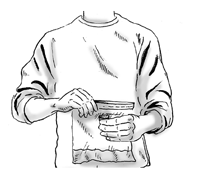
Activity Changing States
Ages 12 and older.
Percy Julian was a professor and a chemist. He practiced chemistry and helped
make many different medicines and household products. Chemistry is sometimes
called the science of change—chemists watch how materials interact with
each other, and they observe how molecules change with heat or mixing. In this
activity, you will observe changes in the materials that are mixed.
You Will Need
- 1 resealable sandwich bag
- 1 tsp baking soda
- 2 tbsp vinegar
- 1 plastic bottle cap
- 8-oz paper cup
- safety goggles
What to Do
Ask an adult to help you with this activity.
- Read all the instructions first. If possible, work with a partner to make it
easier to handle the materials.
- Put on your safety goggles.
- Open the sandwich bag. Place it in the cup and fold the open end of the bag
over the top of the cup. Pour the vinegar into the bag.
- Put the baking soda in the bottle cap. Set it aside.
- Take the bag out of the cup, being careful not to spill the vinegar. Feel
the bottom of the bag and note the temperature of the vinegar.

- Use one hand to place and hold the bottle cap (and baking soda) inside the
bag. Without dropping any baking soda into the vinegar, hold the bag against
your body and use the other hand to carefully remove the air from the bag. Seal
the bag.
- Drop the bottle cap into the vinegar. Gently move the bag to mix the baking
soda and vinegar.
- Observe the changes that occur.
Questions
- What changes did you notice?
- How did the baking soda change? How did the vinegar change?
- Did the temperature of the liquid in the bag change? If so, how?
- What happened to the bag? Why do you think this happened?
- Percy Julian sometimes made new substances in the laboratory by mixing
different chemicals. Did you end up with a different substance than the ones
you started with? Was this new substance a solid, a liquid, or a gas?
Learning More
The Science Discovery Book
by Anthony D. Fredericks, Brad K. Cressman, and Robert Hassler. Scott Foresman,
1987.
Discusses the scientific process and includes chemistry activities for students
in grades 4-6.
The Science Explorer
by Pat Murphy, Ellen Klages, Linda Shore, and the staff of the Exploratorium;
Jason Gorski (Illustrator). Henry Holt, 1996.
Includes many hands-on science experiments, some related to chemistry.
Chemistry
by Ann Newmark. DK Children, 2005.
Considers the nature of chemistry and different types of chemical reactions.
Chemistry
library.thinkquest.org/j001539
Provides chemistry information and experiments for children in grades 4-8.
|

Percy Julian, Chemist
Percy Julian earned his Ph.D. in chemistry from the University of Vienna in
Austria in 1931. He worked in chemistry laboratories and was a careful observer
of change in the materials he used. For example, he saw changes in soybean oil
when water leaked into a tank. This observation helped him discover an
inexpensive process for making the hormone progesterone.
|
  |
|
Forgotten Genius Home |
Send Feedback |
Image Credits |
Support NOVA
|
© |
Created January 2007
|

